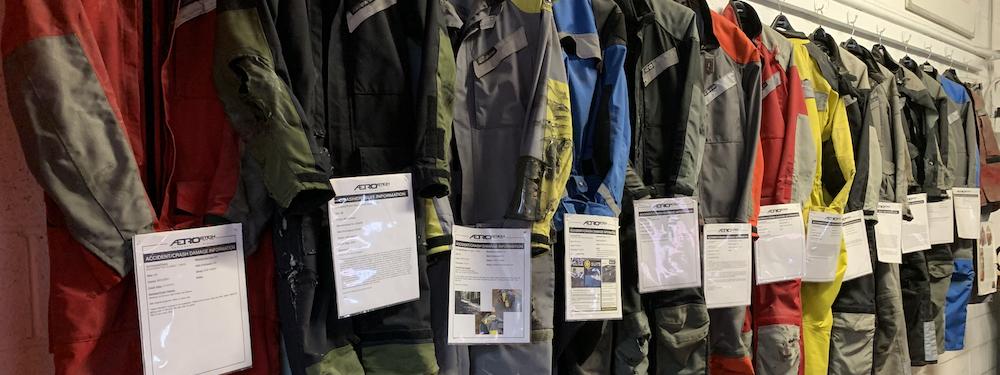How Long Does Gore-Tex® Fabric Last?
This is a great question. We don’t actually know much about this, and very little useful information is available online. What we’ve found there is not precise. The Gore-Tex® membrane on the back side of the Cordura fabric does not seem to have a wear-limit in normal use. It’s good as long as it’s cared for and the outer Cordura fabric is good.
All fabric durability varies by fabric type, weight, weathering and wear. The Cordura we use is fairly heavy weight, which helps it last longer and resist wear and UV exposure better. Our direct material and workmanship warranty is for two years, which I felt would cover the most severe wear scenarios. I.E. - Someone who rides over 150,000/miles a year for two years, on a bike without a windshield or fairing.
Only a very few Aerostich customers ride that much. Based on what we see every day in our repair department, wear varies greatly, and this is very different than age. Some garments still look almost new after ten or even twenty years, but on average most begin look fairly used-up after about 12-15 years of ‘typical wear’.
For those ’typical wear’ scenarios we see come through our repair department, we know the Cordura 500 provides effective crash abrasion-resistance for approximately 12-15 years. We know this from examining many crashed garments which have been sent to us for repairs. Obviously the newer the garment the better, crash-wise, but for ’typical-wear’ garments the protective performance difference between 'brand new' and '10 years old' seems pretty negligible. If you visit our facility, you can see this yourself by looking at a display of about fifteen crash-damaged suits hanging on the wall.
These days we occasionally receive very old garments which show much more age and wear than ’typical wear’. Our repair expert (a co-worker with years of experience) evaluates all of them. If the fabric feels too worn-out based on overall experience, our expert will tag the garment as ‘unsuitable for protection’ before sending it back to the customer. We may still repair a broken zipper (or whatever) even if it no longer meets our protective-function requirements. I’ve forgotten precisely what the ‘unsuitable for protection' tag reads, but it’s something like (paraphrasing): “This garment no longer meets our minimum requirements for rain and crash protection.”
In summary, we don’t know the exact life of the fabric without first inserting all of the above qualifiers. Separately, there also is a rider-psychology aspect to this:
‘Fonzie’ (of TV’s ‘Happy Days’), famously imbued his old worn leather jacket with a kind of special quality protecting him from harm in some kind of magical way. Many riders do this to some extent. It’s natural. Riding produces happy-chemicals in one’s brain, and some of this happiness-feeling is transferred to a rider’s favorite gear and also to their bike. All motion activities produce this happiness effect, which is why skis, bicycles, surfboards and the like are usually also extra-special to their users. Similarly, most very small children (including me when I was very young, and Linus Van Pelt from the ‘Peanuts’ cartoon strip) imbue a favorite blanket or something with a similar kind of special magical value in exactly this way. So, when we see a twenty-year-old well-worn suit, which is all faded and floppy and looks like it’s ready to fall apart, it probably is. After its zipper (or whatever) is fixed it is tagged as no-longer meeting our functional requirements and shipped. When the customer receives it back, it’s out of our control.
-- Mr. Subjective 4-2021

The pants are still black, not bubbly, and not too frayed. This is because I only wear them in cold, wet, or risky conditions, probably still under 100K miles in all. I had Aerostich replace both zippers (with the new waterproof ones) in 2011, and had a local repair shop replace the long zipper (supplied by Aerostich) last month.
All in all, a great value. Never regretted buying a Roadcrafter.
the 97 jackets has several wear-though spots on the G-T lining, mostly from rubbing against the various pads. The 06, despite longer service, has fewer of these, although I believe it was in for repair around 2010. Some issues with velcro coming off the interior of the 06 jacket, new patches (thanks!) fixed that. Both jackets: after about 5-6 years of service, the effectiveness of the washing-followed by DWR re-application seems to lose effectiveness – the outer fabric soaks through, then leaks thru the G-T wear spots on the inside. Wash-in (either top-load machine vs hand-applied in laundry tub) vs spray-on doesn’t seem to matter.
I had a minor crash in grass while wearing the 06 jacket in ’19. Not even a scuff, the grass stain washed out.
Overall, the 06 still works just fine as long as I don’t get caught in a frog-strangler.
I’m probably ready for another one. Let me know when you start making red ones again…